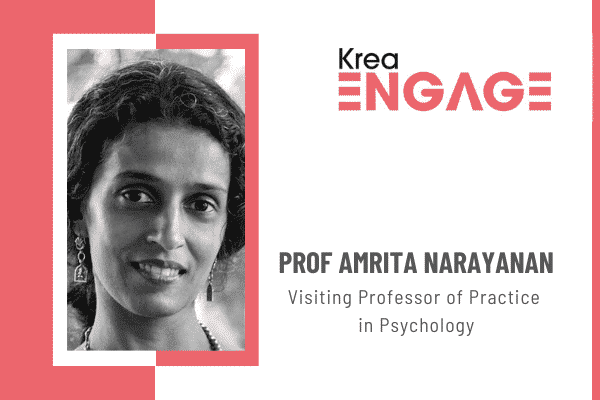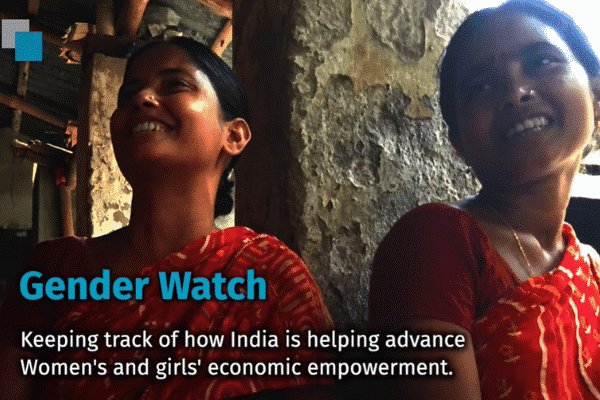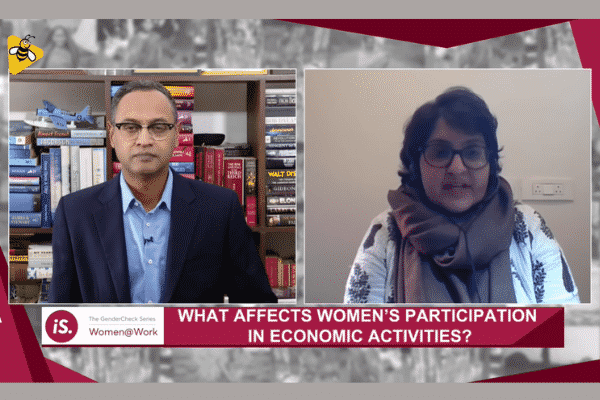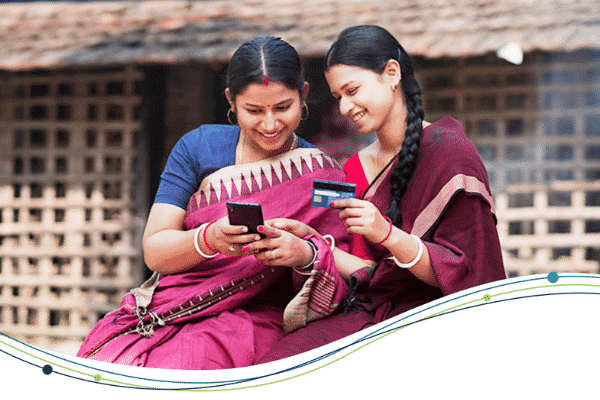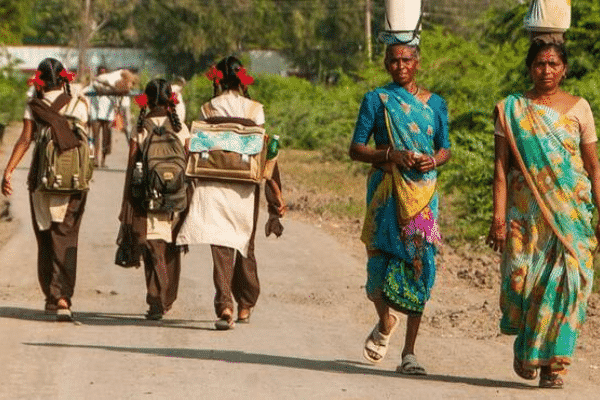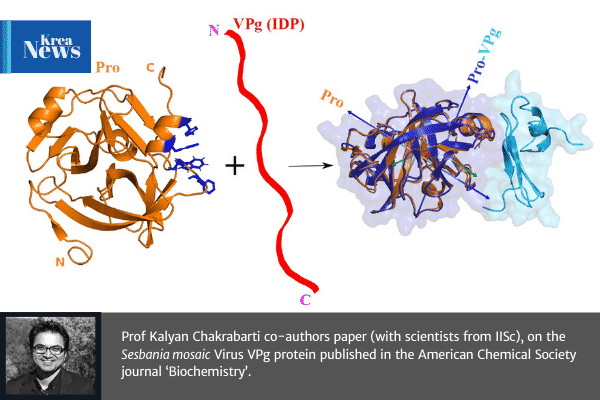As part of the Krea Engage series, Prof Amrita Narayanan in her session titled ‘What can you do with a degree in Psychology?’, discussed in detail about all the career possibilities that come with pursuing the subject in today’s world. Addressing students and counsellors, Prof Amrita shared insights drawn from her career experience and shed light on where a training in Psychology can take a student after graduation. The session also highlighted the specific skills necessary for clinical practice and how the degree serves as a great starting point for careers in science and the arts.
Author: Sanjana
‘The role of networking in the workplace’ with Vijay Sivaram
| In today’s world, networking is viewed as an art form, especially with structures and communicative channels evolving day by day. While the mediums may have shifted, its importance, however, remains unchanged. Packed with insights, Vijay Sivaram – CEO of IT Staffing and Search & Recruitment, overseeing both India and Asia Pacific operations at Quess Corp – shared his knowledge on effective networking, where he went on to highlight the importance of improving one’s communication skills from a recruiter’s perspective. The session also touched upon areas relevant to young individuals joining the workforce. |
Prof Madhuri Saripalle co-authors chapter on mango value chains in India
| Dr Madhuri Saripalle – Associate Professor of Economics at IFMR GSB, Krea University – co-authored a chapter on Mango Value Chains in India as part of an edited volume titled ‘Transforming Agriculture in South Asia: Role of Value Chains and Contract Farming’. Published by Routledge, the study analyses numerous markets and value chains for mango namely HOPCOMS, SAFAL, APMC and pre and post-flowering contracts with wholesale agents that have different implications for farmer profitability. |
‘Gender Watch’ – an informative video series by IWWAGE
IWWAGE brings to you a video series called, “Gender Watch” which presents in a capsule format news stories, data highlights and the latest research and thinking on gender issues in India, particularly related to initiatives and interventions to empower women economically. The launch episode can be viewed here. For upcoming episodes, visit the Gender Watch section.
Examining the barriers to women’s employment
IWWAGE and IndiaSpend have come together for a year-long partnership to examine and analyse issues around women empowerment and strengthen the narrative that will encourage and allow for equal participation of women in economic activity. The partnership kicked off with a video interview featuring Soumya Kapoor Mehta, Head – IWWAGE, as part of the Women@Work 2.0 series, examining barriers and solutions to getting more women in paid work. Watch the interview here.
Strengthening socio-economic rights of women: IWWAGE examines SEWA’s approach in West Bengal & Jharkhand
Women working in India’s informal sector face several vulnerabilities and are often denied decent working conditions and wages. Evidence shows that working poor in the informal economy, particularly women, need to organise themselves to overcome the structural disadvantages. SEWA’s programme in Jharkhand and West Bengal aims to increase the collective bargaining strength of the women informal workers, strengthen the workers’ movement, nurture and develop effective grassroots leadership; and also improve community’s access and understanding of basic services. The study, undertaken by IWWAGE in collaboration with SEWA, assesses the programme against these objectives with the aim to understand the impact of various components. Read the detailed report here.
Enhancing livelihood opportunities with digital solutions for SHGs in Chhattisgarh
In Chhattisgarh, IWWAGE is partnering with the State Rural Livelihoods Mission (SRLM) and Haqdarshak Empowerment Solutions Private Limited (HESPL) to train SHG members on a digital application, which can enhance their livelihood opportunities. In addition to collaborating on the implementation of this livelihood model, LEAD and IWWAGE are also conducting an impact and process evaluation of the Haqdarshak programme, which will answer questions on its effectiveness and efficacy. Read more about the project and the milestones here.
How official data miss details on half of India’s citizens
Lack of sex-disaggregated data and other gender-related gaps in Indian government’s official data sources is making it difficult to track issues such as girls’ and women’s employment, asset ownership, health, sanitation and education. This results in a limited understanding of gender issues and poorly designed policies and programmes. As part of their Data Gaps series, IWWAGE’s second story examines which women-specific data points are not collated or made public, and how this makes women invisible and hinders progress towards gender-equality goals. Read the article here.
Addressing the pandemic’s impact on creative economy
In an engaging session with the students of Krea University, Navaneeth LV – Chief Executive Officer of The Hindu Group – shared his insights on the many challenges and opportunities the creative economy continues to face in light of the ongoing pandemic. From sharing why reader revenue is far more important than advertising to laying an emphasis on working towards digital transformation — the session shed light on what legacy publications are going through and how they are tackling these challenges. Prof Anil Srinivasan – Associate Professor of Practice, Literature & the Arts – moderated the session. Watch the recording of the session here.
Prof Kalyan Chakrabarti co-authors paper on “Aromatic Interactions Drive the Coupled Folding and Binding of the Intrinsically Disordered Sesbania mosaic Virus VPg Protein”
Prof Kalyan Chakrabarti – Assistant Professor of Biological Science & Chemistry, Krea University – co-authors with scientists at IISc for a paper on “Aromatic Interactions Drive the Coupled Folding and Binding of the Intrinsically Disordered Sesbania mosaic Virus VPg Protein” published in the American Chemical Society journal ‘Biochemistry’.
About the paper:
The cells are the tiny units of life. Protein molecules are the engines that carry out all the necessary work within the cell. But, how are the engines assembled within the cell? A team of scientists, including Prof Kalyan Chakrabarti, have answered this question in an article published in the American Chemical Society journal ‘Biochemistry’. The work, partially funded by the Krea Intramural Fellowship awarded in 2019, discusses a specific problem of viral infection in plants which has the potential to provide a blueprint for preventing viral infections in animals too.
Abstract:
The plant Sesbania mosaic virus [a (+)-ssRNA sobemovirus] VPg protein is intrinsically disordered in solution. For the virus life cycle, the VPg protein is essential for replication and for polyprotein processing that is carried out by a virus-encoded protease. The nuclear magnetic resonance (NMR)-derived tertiary structure of the protease-bound VPg shows it to have a novel tertiary structure with an α-β-β-β topology. The quaternary structure of the high-affinity protease–VPg complex (≈27 kDa) has been determined using HADDOCK protocols with NMR (residual dipolar coupling, dihedral angle, and nuclear Overhauser enhancement) restraints and mutagenesis data as inputs. The geometry of the complex is in excellent agreement with long-range orientational restraints such as residual dipolar couplings and ring-current shifts. A “vein” of aromatic residues on the protease surface is pivotal for the folding of VPg via intermolecular edge-to-face π···π stacking between Trp271 and Trp368 of the protease and VPg, respectively, and for the CH···π interactions between Leu361 of VPg and Trp271 of the protease. The structure of the protease–VPg complex provides a molecular framework for predicting sites of important posttranslational modifications such as RNA linkage and phosphorylation and a better understanding of the coupled folding upon binding of intrinsically disordered proteins. The structural data presented here augment the limited structural data available on viral proteins, given their propensity for structural disorder.
Reference: Karuna Dixit, N. Megha Karanth, Smita Nair, Khushboo Kumari, Kalyan S. Chakrabarti, Handanahal S. Savithri, and Siddhartha P. Sarma | Biochemistry 2020 59 (49), 4663-4680 | DOI: 10.1021/acs.biochem.0c00721
Read the complete paper, here.
